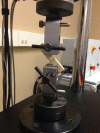A Biomechanical Comparison of Screw and Plate Fixations for Scaphoid Fractures
- PMID: 29383280
- PMCID: PMC5788748
- DOI: 10.1055/s-0037-1606123
A Biomechanical Comparison of Screw and Plate Fixations for Scaphoid Fractures
Abstract
Background Headless screw fixation is the current gold standard of surgical repair for scaphoid fractures. However, maintaining reduction of certain types of scaphoid fractures is challenging with a compression screw. Plate fixation may offer superior fixation in some scaphoid fractures, particularly those with comminution, nonunion, segmental bony defects, and osteopenic or osteoporotic bone. Purpose This study questions whether method of fixation is a determinant in load to failure in segmental scaphoid fractures, and whether any fixation provides a greater mechanical advantage in simulated normal versus osteoporotic bone. Materials and Methods Polyurethane models were fashioned to simulate scaphoids with 3-mm segmental defects. Defects were bridged by one of three constructs: a locking plate, a nonlocking plate, or a headless compression screw. Three models for each fixation construct were tested for both simulated normal and osteoporotic bone density. Load to failure was recorded as the load at which the 3-mm segmental defect was closed. Results Gap closure occurred in all trials. In simulated normal bone, there were no statistically significant differences in load to failure between fixation methods. In simulated osteoporotic bone, the locking plate had a 28% greater load to failure as compared with screw fixation. Conclusion While biomechanical testing shows that plate and screw fixations are equivalent in normal density bone for fixation of a segmental scaphoid defect, locking plates are superior to screw fixation in simulated osteoporotic bone models. Clinical Relevance Plate fixation may provide superior fixation for complex scaphoid fractures, particularly in osteopenic bone.
Keywords: biomechanical; nonunion; plate; scaphoid.
Conflict of interest statement
Figures
Similar articles
-
A Comparison of Plate Versus Screw Fixation for Segmental Scaphoid Fractures: A Biomechanical Study.Hand (N Y). 2019 Mar;14(2):203-208. doi: 10.1177/1558944717732065. Epub 2017 Sep 23. Hand (N Y). 2019. PMID: 28942683 Free PMC article.
-
Scaphoid Fracture Fixation in a Nonunion Model: A Biomechanical Study Comparing 3 Types of Fixation.J Hand Surg Am. 2018 Mar;43(3):221-228. doi: 10.1016/j.jhsa.2017.10.005. Epub 2017 Nov 11. J Hand Surg Am. 2018. PMID: 29132789
-
A Biomechanical Comparison of Fifth Metatarsal Jones Fracture Fixation Methods.Am J Sports Med. 2018 Apr;46(5):1220-1227. doi: 10.1177/0363546517753376. Epub 2018 Feb 21. Am J Sports Med. 2018. PMID: 29466679
-
The Authors' Technique for Volar Plating of Scaphoid Nonunion.Hand Clin. 2019 Aug;35(3):281-286. doi: 10.1016/j.hcl.2019.03.009. Epub 2019 May 11. Hand Clin. 2019. PMID: 31178086 Review.
-
Headless compression screw fixation of scaphoid fractures.Hand Clin. 2010 Aug;26(3):351-61, vi. doi: 10.1016/j.hcl.2010.04.005. Epub 2010 Jun 18. Hand Clin. 2010. PMID: 20670800 Review.
Cited by
-
Postoperative Outcomes of Volar Plate Fixation in Cases of Scaphoid Deformity or Nonunion: A Case Series.J Wrist Surg. 2020 Aug;9(4):304-311. doi: 10.1055/s-0040-1710383. Epub 2020 May 20. J Wrist Surg. 2020. PMID: 32760609 Free PMC article.
-
Scaphoid Nonunion Volar Plating with Pure Nonvascularized Cancellous Autograft.JBJS Essent Surg Tech. 2021 May 27;11(2):e20.00029. doi: 10.2106/JBJS.ST.20.00029. eCollection 2021 Apr-Jun. JBJS Essent Surg Tech. 2021. PMID: 34277132 Free PMC article.
-
[Palmar angular stable plate fixation of nonunions and comminuted fractures of the scaphoid].Oper Orthop Traumatol. 2019 Oct;31(5):433-446. doi: 10.1007/s00064-019-00623-0. Epub 2019 Aug 21. Oper Orthop Traumatol. 2019. PMID: 31435702 Review. German.
-
Volar Scaphoid Plating for Nonunion: A Multicenter Case Series Study.J Wrist Surg. 2020 Jun;9(3):225-229. doi: 10.1055/s-0040-1702199. Epub 2020 Mar 6. J Wrist Surg. 2020. PMID: 32509427 Free PMC article.
-
Modified Matti-Russe technique using a "butterfly bone graft" for treatment of scaphoid non-union.J Orthop. 2019 Nov 27;19:63-66. doi: 10.1016/j.jor.2019.11.030. eCollection 2020 May-Jun. J Orthop. 2019. PMID: 32021039 Free PMC article.
References
-
- Smith D K, Cooney W P, III, An K N, Linscheid R L, Chao E Y.The effects of simulated unstable scaphoid fractures on carpal motion J Hand Surg Am 198914(2 Pt 1):283–291. - PubMed
-
- Ruby L K, Stinson J, Belsky M R. The natural history of scaphoid non-union. A review of fifty-five cases. J Bone Joint Surg Am. 1985;67(03):428–432. - PubMed
-
- Watanabe K. Analysis of carpal malalignment caused by scaphoid nonunion and evaluation of corrective bone graft on carpal alignment. J Hand Surg Am. 2011;36(01):10–16. - PubMed
-
- Leixnering M, Pezzei C, Weninger P et al.First experiences with a new adjustable plate for osteosynthesis of scaphoid nonunions. J Trauma. 2011;71(04):933–938. - PubMed
LinkOut - more resources
Full Text Sources
Other Literature Sources
Miscellaneous


